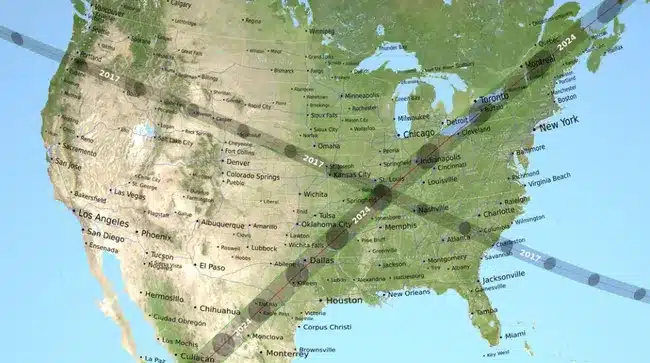On August 21, 2017, a remarkable astronomical event captivated viewers across the United States as a total solar eclipse traversed the nation from the Pacific to the Atlantic. This event marked the first coast-to-coast totality in nearly a century, casting a narrow corridor across 14 U.S. states under the shadow of the moon. The eclipse’s path extended from Oregon in the northwest to South Carolina in the southeast, offering a breathtaking spectacle to millions of spectators.
Now, a similar phenomenon is set to unfold once more with the upcoming total solar eclipse on April 8, 2024. However, this time, the trajectory of the eclipse appears to follow a different course, tracking from southwest to northeast. Along with the change in direction, there are notable differences in other aspects of the eclipse as well. For instance, the duration of totality will be longer, lasting 4 minutes and 28 seconds compared to the 2 minutes and 40 seconds of totality experienced in 2017. Additionally, the width of the path of totality will be broader, spanning approximately 115 miles compared to the 70 miles in 2017. Consequently, many more people will have the opportunity to witness totality, particularly as the event coincides with the sun’s proximity to solar maximum.
Eclipse expert Dan McGlaun emphasized the distinct circumstances surrounding each eclipse, attributing these differences to the relative positions of the sun, moon, and Earth. While the distance from Earth to the sun remains relatively constant, the moon’s elliptical orbit causes variations in its distance from Earth. During the upcoming eclipse on April 8, the moon will be slightly closer to Earth, resulting in a larger diameter of its conical shadow on Earth’s surface. As a result, the path of totality will be wider, covering a larger area.
The movement of the moon’s shadow across Earth’s surface is influenced by various factors, including the moon’s orbital path and the tilt of Earth’s axis. McGlaun explained that the path of totality appears to shift due to Earth’s rotation and axial tilt. In 2017, Earth’s rotation during totality created the illusion of the path descending, while in 2024, the opposite effect occurs, with Earth’s rotation making the path appear to ascend. These factors underscore the dynamic interplay between celestial bodies and Earth’s motion during a solar eclipse.
Moreover, the 2017 and 2024 eclipses intersect, forming an “Eclipse Crossroads” in certain regions where totality will occur twice within a span of seven years. This convergence creates unique opportunities for observation and study, particularly in areas like southeastern Missouri, southern Illinois, and western Kentucky.
Another significant difference between the two eclipses is the sun’s magnetic activity, which follows an 11-year cycle known as the solar cycle. The 2017 eclipse occurred during a period of low magnetic activity, while the 2024 eclipse is expected to coincide with a period of heightened activity during solar maximum. This variation in solar activity can affect the appearance of phenomena such as sunspots and the solar corona, enriching the viewing experience for spectators.
Overall, the upcoming total solar eclipse promises to offer a spectacular celestial display, inviting enthusiasts and researchers alike to witness this extraordinary event. By understanding the intricate dynamics at play, observers can appreciate the unique characteristics of each eclipse and the profound influence of celestial mechanics on Earth’s natural phenomena.

